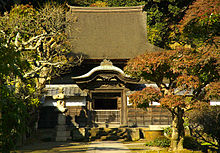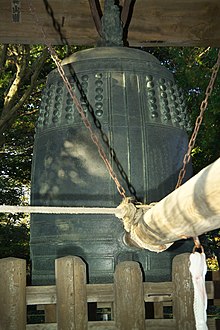Engaku-ji
| Zuirokuzan Dai-Engaku Kōshō Zenji | |
|---|---|
 | |
| Location | |
| Country | Japan |
| Website | |
| http://www.engakuji.or.jp/index.shtml Template:Ja icon | |



Not to be confused with Enryaku-ji in Kyoto.
Zuirokuzan Engaku Kōshō Zenji (瑞鹿山円覚興聖禅寺), or Engaku-ji (円覚寺), is one of the most important Zen Buddhist temple complexes in Japan and is ranked second among Kamakura's Five Mountains. It is situated in the city of Kamakura, in Kanagawa prefecture to the south of Tokyo. It is very close to the Kita-Kamakura railway station on the Tokyo to Yokosuka line, and indeed the railway tracks cut across the formal entrance to the temple compound, which (showing Chinese influence) is by a path beside a pond which is crossed by a small bridge.
History
The temple was founded in 1282 by a Chinese Zen monk at the request of the then ruler of Japan, the regent Hōjō Tokimune after he had repelled a joint Mongolian-Korean invasion in the period 1274 to 1281. Tokimune had a long-standing commitment to Zen and the temple was intended to honour those of both sides who died in the war, as well as serving as a centre from which the influence of Zen could be spread. According to the records of the time, when building work started a copy of the Sutra of Perfect Enlightenment (in Japanese, engaku-kyō 円覚経) was dug out of the hillside in a stone chest during the initial building works, giving its name to the temple.
The fortunes of the temple have waxed and waned over the centuries. Its present form is owed to the Zen priest Seisetsu, who reconstructed and consolidated it towards the end of the Edo era. In the Meiji era, Engaku-ji became the chief centre for Zen instruction in the Kantō region; Kosen Roshi and Soyen Shaku were successively abbots in this period, and Daisetz Teitaro Suzuki was a student under them. Zazen courses are still held in the temple.
Structures
Fire has damaged many of the buildings at different times, and the dates given below refer to the building of the structures currently seen. From the entrance, the buildings of the temple rise up a wooded hillside, with the major buildings in a straight line in the Chinese style; the austere buildings and the trees blending in a satisfying overall composition. There are altogether 18 temples on the site. Among the buildings and other monuments are:
- the two-storied main gate, or Sanmon (山門), with framed calligraphy by the Emperor Fushimi;
- a large modern Butsu-den (仏殿; main hall;[1] 1964)
- Shari-den (舎利殿; reliquary hall[2]), built in the sixteenth century in the style of the Chinese Song dynasty, which houses what is claimed to be a tooth of the Buddha;
- the thatched Butsunichi-an (仏日庵) which is the burial site of Hōjō Tokimune;
- Ōbai-in (黄梅院), a small thatched temple containing a statue of Kannon;
- Great Bell (大鐘, Ōgane) (1301), at 2.5 metres tall the largest of all the many temple bells of Kamakura.
- grave of film director Yasujirō Ozu, marked mu (無, nothingness)[3]
Of these, the Shari-den and the Great Bell have been designated as National Treasures.
Access and amenities
There is an admission fee (as of 2012[update], 300 yen) for visitors to enter the temple complex, and additional similar charges to enter a few of the buildings. Booths selling tourist items are located near the entrance, below the San-mon, and there are refreshment facilities in the garden of the Shari-den and at the platform where the Great Bell is located, from where there are extensive views across the valley to other temple complexes in the Kita-Kamakura neighbourhood, such as Jōchi-ji and Tōkei-ji.
See also
- For an explanation of terms concerning Japanese Buddhism, Japanese Buddhist art, and Japanese Buddhist temple architecture, see the Glossary of Japanese Buddhism.
- List of National Treasures of Japan (crafts-others)
Notes
- ^ Butsuden 仏殿 at Japanese Architecture and Art Net Users System
- ^ Shariden 舎利殿 at Japanese Architecture and Art Net Users System
- ^ Desser, David (1997). Ozu's Tokyo Story (Cambridge Film Handbooks). Cambridge University Press. p. 102. ISBN 978-0-521-48435-0.
References
- Richmond, S., & Dodd, J. (2005). Rough guide to Japan, 3rd edn. New York: Rough Guides.
- Information leaflet issued by the temple authorities
External links
 Kamakura travel guide from Wikivoyage
Kamakura travel guide from Wikivoyage- Official website Template:Ja icon
- Engakuji Temple at Kamakura: History & Historic Sites
- Engakuji (overview)
